Abstract
There is continuing controversy, extending into regulatory matters, over the significance to human health of positive results in carcinogenicity studies in animals using the gavage technique as the route of exposure. Our review of a nonrandom sample of 117 chemicals or chemical processes listed as known or reasonably anticipated to be carcinogenic in the National Toxicology Program's Third Annual Report on Carcinogens provides support for the validity of the gavage route in such studies. Twenty-three chemicals among the 117 substances and processes listed were positive by gavage. Twenty of these 23 chemicals were also appropriately studied by at least one other route of exposure. Thus, we were able to evaluate the extent to which positive gavage results were confirmed by another route of exposure in this sample. Nineteen (or 95%) of the twenty chemicals were positive for carcinogenicity by at least one other nongavage route in carcinogenicity bioassays. Moreover, in each of these 19 cases, positive carcinogenesis results were obtained by a nongavage route in the same species of animal where gavage administration led to the induction of cancer. All of the 23 gavage-positive chemicals induced tumors distal to the site of administration in at least one study, as did all 15 chemicals which were also positive by subcutaneous injection. We emphasize, however, the limited scope of our survey. We have not evaluated all chemicals that have tested positive by gavage and by at least one alternative route, nor have we assessed those chemicals found to be negative by the gavage route.(ABSTRACT TRUNCATED AT 250 WORDS)
Full text
PDF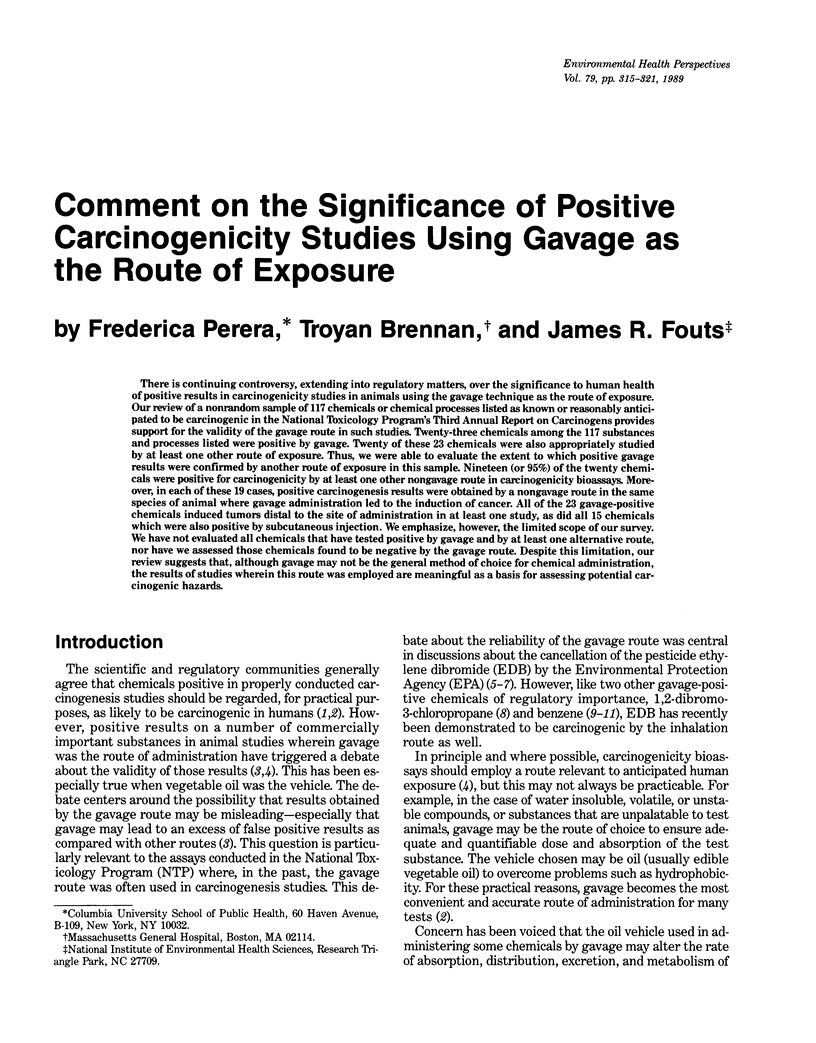
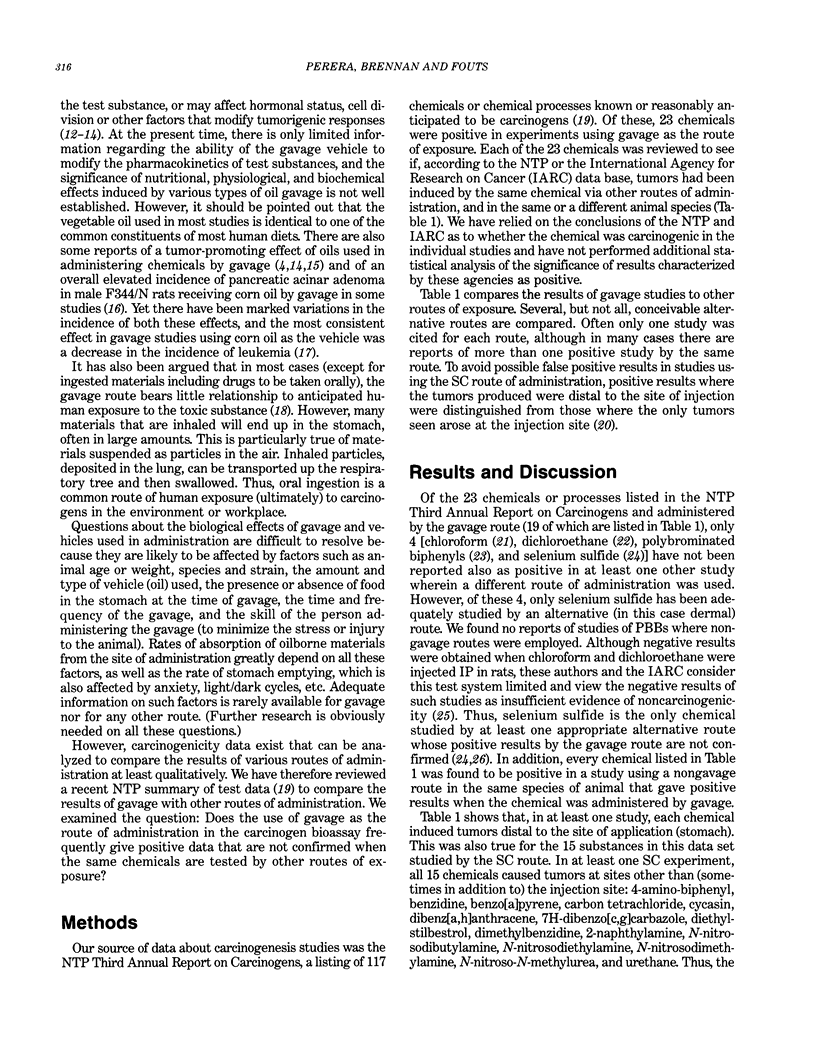
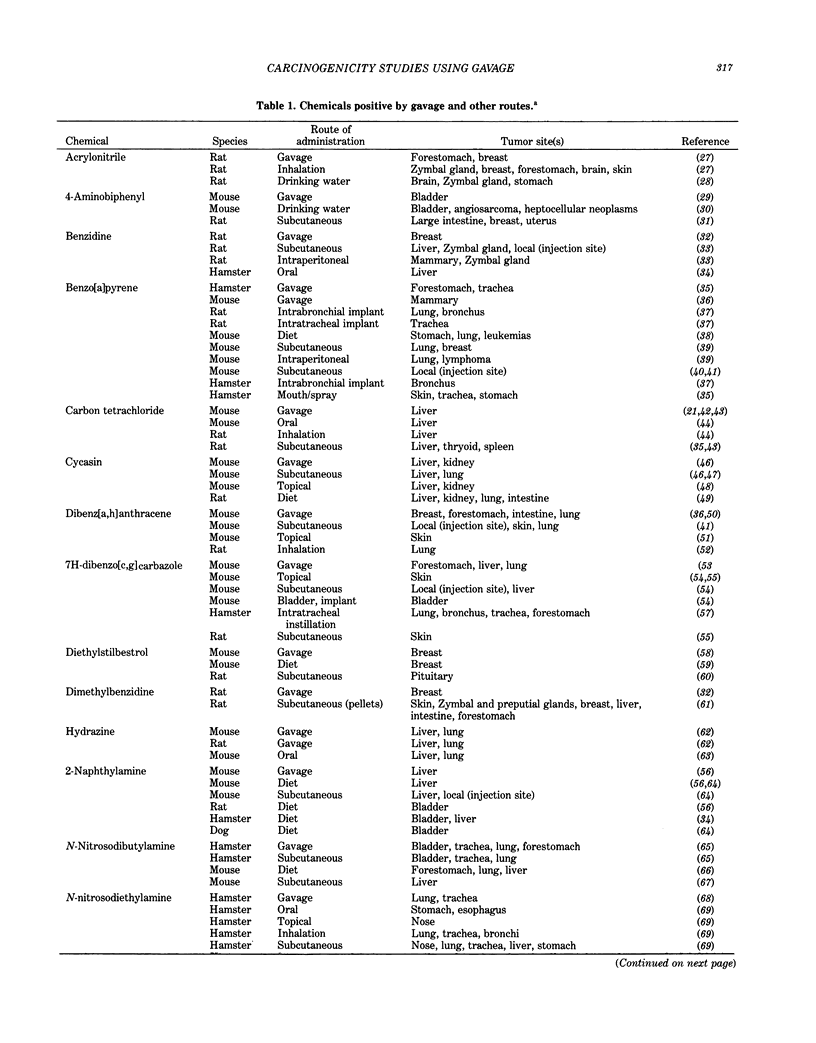
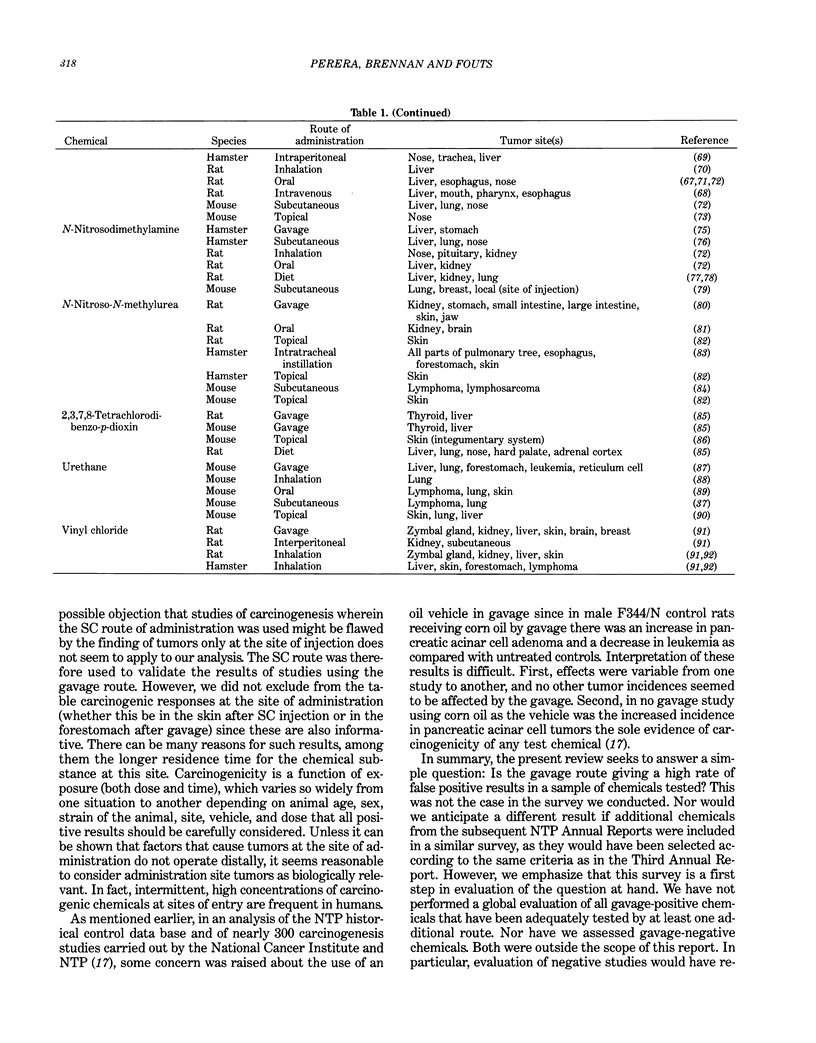
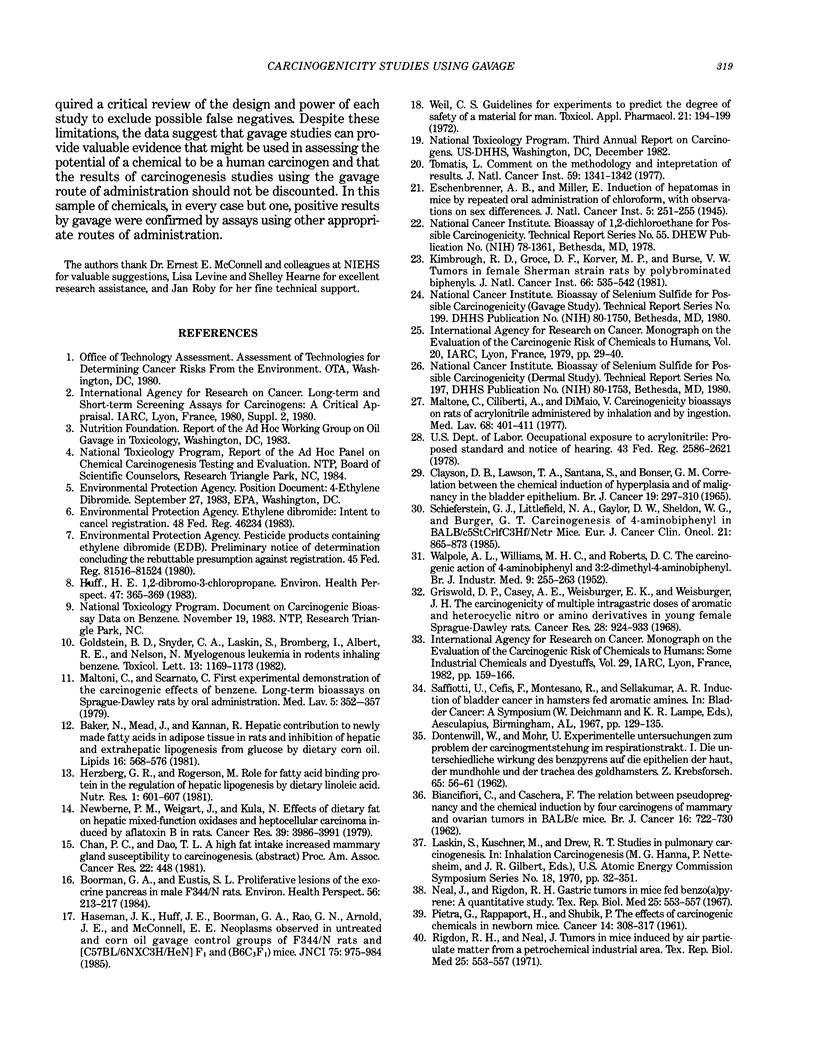
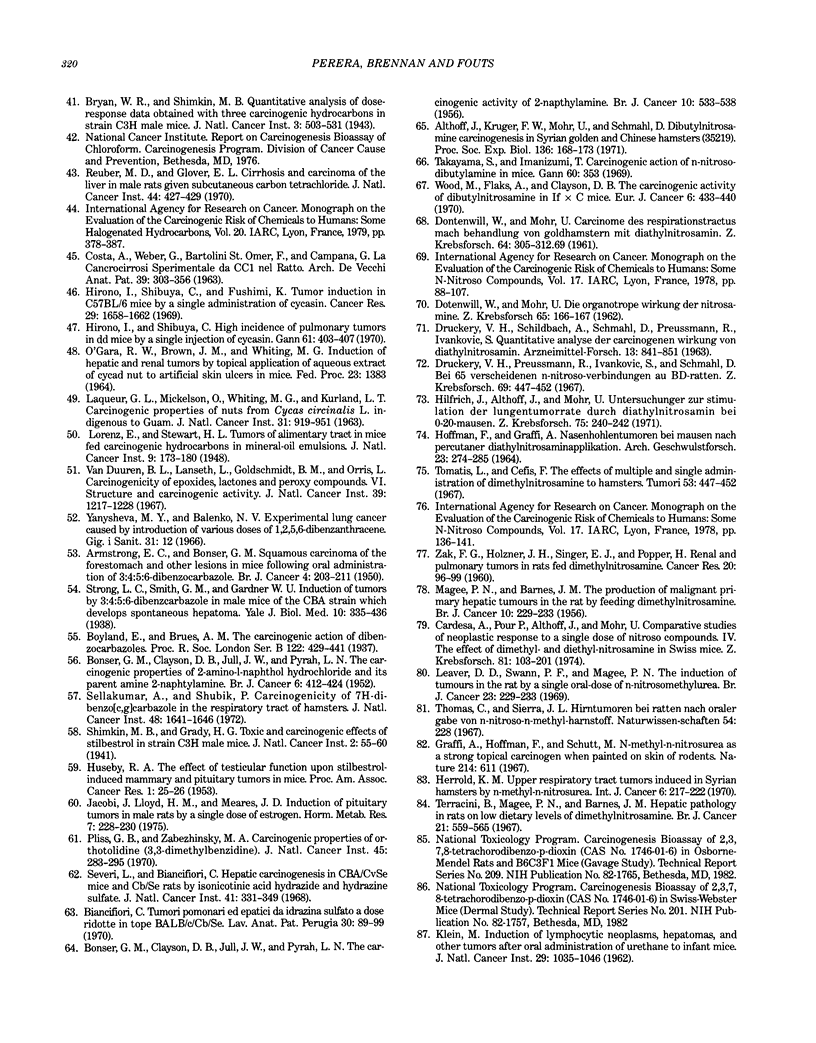
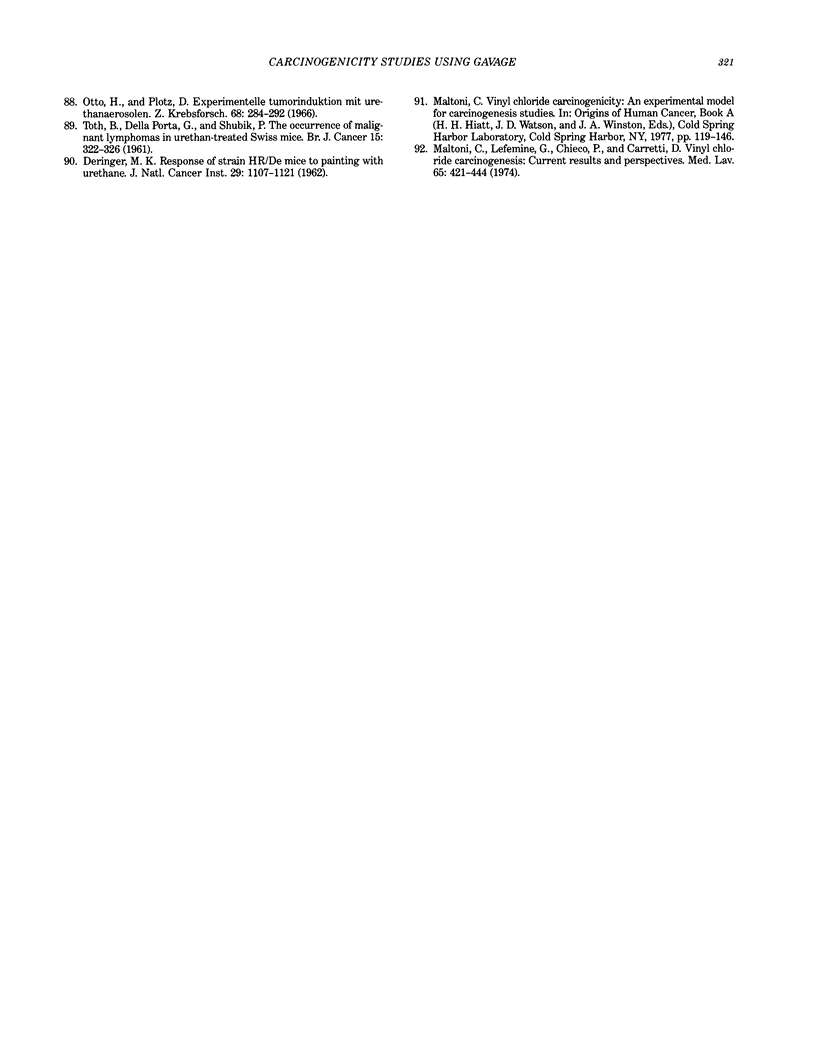
Selected References
These references are in PubMed. This may not be the complete list of references from this article.
- ARMSTRONG E. C., BONSER G. M. Squamous carcinoma of the fore-stomach and other lesions in mice following oral administration of 3:4:5:6-dibenzcarbazole. Br J Cancer. 1950 Jun;4(2):203–211. doi: 10.1038/bjc.1950.20. [DOI] [PMC free article] [PubMed] [Google Scholar]
- Althoff J., Krüger F. W., Mohr U., Schmahl D. Dibutylnitrosamine carcinogenesis in Syrian Golden and Chinese hamsters. Proc Soc Exp Biol Med. 1971 Jan;136(1):168–173. doi: 10.3181/00379727-136-35219. [DOI] [PubMed] [Google Scholar]
- BIANCIFIORI C., CASCHERA F. The relation between pseudopregnancy and the chemical induction by four carcinogens of mammary and ovarian tumours in BALB/C mice. Br J Cancer. 1962 Dec;16:722–730. doi: 10.1038/bjc.1962.84. [DOI] [PMC free article] [PubMed] [Google Scholar]
- BONSER G. M., CLAYSON D. B., JULL J. W., PYRAH L. N. The carcinogenic activity of 2-naphthylamine. Br J Cancer. 1956 Sep;10(3):533–538. doi: 10.1038/bjc.1956.62. [DOI] [PMC free article] [PubMed] [Google Scholar]
- BONSER G. M., CLAYSON D. B., JULL J. W., PYRAH L. N. The carcinogenic properties of 2-amino-1-naphthol hydrochloride and its parent amine 2-naphthylamine. Br J Cancer. 1952 Dec;6(4):412–424. doi: 10.1038/bjc.1952.47. [DOI] [PMC free article] [PubMed] [Google Scholar]
- Baker N., Mead J., Jr, Kannan R. Hepatic contribution to newly made fatty acids in adipose tissue in rats and inhibition of hepatic and extrahepatic lipogenesis from glucose by dietary corn oil. Lipids. 1981 Aug;16(8):568–576. doi: 10.1007/BF02534901. [DOI] [PubMed] [Google Scholar]
- Biancifiori C. Tumori polmonari ed epatici da idrazina solfato a dosi ridotte in topi BALB-c-Cb-Se. Lav Ist Anat Istol Patol Univ Studi Perugia. 1970;30(2):89–99. [PubMed] [Google Scholar]
- Boorman G. A., Eustis S. L. Proliferative lesions of the exocrine pancreas in male F344/N rats. Environ Health Perspect. 1984 Jun;56:213–217. doi: 10.1289/ehp.8456213. [DOI] [PMC free article] [PubMed] [Google Scholar]
- CLAYSON D. B., LAWSON T. A., SANTANA S., BONSER G. M. CORRELATION BETWEEN THE CHEMICAL INDUCTION OF HYPERPLASIA AND OF MALIGNANCY IN THE BLADDER EPITHELIUM. Br J Cancer. 1965 Jun;19:297–310. doi: 10.1038/bjc.1965.34. [DOI] [PMC free article] [PubMed] [Google Scholar]
- Caces E., de Lauture H., Vol S., Tichet J., Boulard P. Le depistage systematique de la brucellose humaine par le test au Rose Bengale en milieu agricole d'apres une etude dans le centre-ouest de la France sur 89 000 exploitants et salaries. Comp Immunol Microbiol Infect Dis. 1978;1(1-2):107–114. doi: 10.1016/0147-9571(78)90017-6. [DOI] [PubMed] [Google Scholar]
- DERINGER M. K. Response of strain HR/De mice to painting with urethan. J Natl Cancer Inst. 1962 Dec;29:1107–1121. [PubMed] [Google Scholar]
- DONTENWILL W., MOHR U. [The organotropic effect of nitrosamines]. Z Krebsforsch. 1962;65:166–167. [PubMed] [Google Scholar]
- DRUCKREY H., SCHILDBACH A., SCHMAEHL D., PREUSSMANN R., IVANKOVIC S. QUANTITATIVE ANALYSE DER CARCINOGENEN WIRKUNG VON DIAETHYLNITROSAMIN. Arzneimittelforschung. 1963 Oct;13:841–851. [PubMed] [Google Scholar]
- Graffi A., Hoffmann A., Schütt M. Nmethyl-N-nitrosourea as a strong topical carcinogen when painted on skin of rodents. Nature. 1967 May 6;214(5088):611–611. doi: 10.1038/214611a0. [DOI] [PubMed] [Google Scholar]
- Griswold D. P., Jr, Casey A. E., Weisburger E. K., Weisburger J. H. The carcinogenicity of multiple intragastric doses of aromatic and heterocyclic nitro or amino derivatives in young female sprague-dawley rats. Cancer Res. 1968 May;28(5):924–933. [PubMed] [Google Scholar]
- Haseman J. K., Huff J. E., Rao G. N., Arnold J. E., Boorman G. A., McConnell E. E. Neoplasms observed in untreated and corn oil gavage control groups of F344/N rats and (C57BL/6N X C3H/HeN)F1 (B6C3F1) mice. J Natl Cancer Inst. 1985 Nov;75(5):975–984. doi: 10.1093/jnci/75.5.975. [DOI] [PubMed] [Google Scholar]
- Herrold K. M. Upper respiratory tract tumors induced in Syrian hamsters by N-methyl-N-nitrosourea. Int J Cancer. 1970 Sep 15;6(2):217–222. doi: 10.1002/ijc.2910060208. [DOI] [PubMed] [Google Scholar]
- Hilfrich J., Althoff J., Mohr U. Untersuchungen zur Stimulation der Lungentumorrate durch Diäthylnitrosamin bei O-20-Mäusen. Z Krebsforsch. 1971 Feb 26;75(3):240–242. [PubMed] [Google Scholar]
- Hirono I., Shibuya C., Fushimi K. Tumor induction in C57BL-6 mice by a single administration of cycasin. Cancer Res. 1969 Sep;29(9):1658–1662. [PubMed] [Google Scholar]
- Hirono I., Shibuya C. High incidence of pulmonary tumors in dd mice by a single injection of cycasin. Gan. 1970 Oct;61(5):403–407. [PubMed] [Google Scholar]
- Hoffmann F., Graffi A. Nasenhöhlentumoren bei Mäusen nach percutaner Diäthylnitrosaminapplikation. Arch Geschwulstforsch. 1964;23(4):274–288. [PubMed] [Google Scholar]
- KLEIN M. Induction of lymphocyticlasms, hepatomas, and other tumors after oral administration of urethan to infant mice. J Natl Cancer Inst. 1962 Dec;29:1035–1046. [PubMed] [Google Scholar]
- Kimbrough R. D., Groce D. F., Korver M. P., Burse V. W. Induction of liver tumors in female Sherman strain rats by polybrominated biphenyls. J Natl Cancer Inst. 1981 Mar;66(3):535–542. [PubMed] [Google Scholar]
- LAQUEUR G. L., MICKELSEN O., WHITING M. G., KURLAND L. T. CARCINOGENIC PROPERTIES OF NUTS FROM CYCAS CIRCINALIS L. INDIGENOUS TO GUAM. J Natl Cancer Inst. 1963 Oct;31:919–951. [PubMed] [Google Scholar]
- Maltoni C., Ciliberti A., Di Maio V. Carcinogenicity bioassays on rats of acrylonitrile administered by inhalation and by ingestion. Med Lav. 1977 Nov-Dec;68(6):401–411. [PubMed] [Google Scholar]
- Maltoni C., Lefemine G., Chieco P., Carretti D. Vinyl chloride carcinogenesis: current results and perspectives. Med Lav. 1974 Nov-Dec;65(11-12):421–444. [PubMed] [Google Scholar]
- Neal J., Rigdon R. H. Gastric tumors in mice fed benzo(a)pyrene: a quantitative study. Tex Rep Biol Med. 1967 Winter;25(4):553–557. [PubMed] [Google Scholar]
- Neal J., Rigdon R. H. Gastric tumors in mice fed benzo(a)pyrene: a quantitative study. Tex Rep Biol Med. 1967 Winter;25(4):553–557. [PubMed] [Google Scholar]
- Newberne P. M., Weigert J., Kula N. Effects of dietary fat on hepatic mixed-function oxidases and hepatocellular carcinoma induced by aflatoxin B1 in rats. Cancer Res. 1979 Oct;39(10):3986–3991. [PubMed] [Google Scholar]
- O'GARA R. W., BROWN J. M., WHITING M. G. INDUCTION OF HEPATIC AND RENAL TUMORS BY TOPICAL APPLICATION OF AQUEOUS EXTRACT OF CYCAD NUT TO ARTIFICIAL SKIN ULCERS IN MICE. Fed Proc. 1964 Nov-Dec;23:1382–1383. [PubMed] [Google Scholar]
- PIETRA G., RAPPAPORT H., SHUBIK P. The effects of carcinogenic chemicals in newborn mice. Cancer. 1961 Mar-Apr;14:308–317. doi: 10.1002/1097-0142(196103/04)14:2<308::aid-cncr2820140211>3.0.co;2-n. [DOI] [PubMed] [Google Scholar]
- Pliss G. B., Zabezhinsky M. A. Carcinogenic properties of orthotolidine (3,3'-dimethylbenzidine). J Natl Cancer Inst. 1970 Aug;45(2):283–295. [PubMed] [Google Scholar]
- Reuber M. D., Glover E. L. Cirrhosis and carcinoma of the liver in male rats given subcutaneous carbon tetrachloride. J Natl Cancer Inst. 1970 Feb;44(2):419–427. [PubMed] [Google Scholar]
- Schieferstein G. J., Littlefield N. A., Gaylor D. W., Sheldon W. G., Burger G. T. Carcinogenesis of 4-aminobiphenyl in BALB/cStCrlfC3Hf/Nctr mice. Eur J Cancer Clin Oncol. 1985 Jul;21(7):865–873. doi: 10.1016/0277-5379(85)90227-5. [DOI] [PubMed] [Google Scholar]
- Sellakumar A., Shubik P. Carcinogenicity of 7H-dibenzo[c,g]carbazole in the respiratory tract of hamsters. J Natl Cancer Inst. 1972 Jun;48(6):1641–1646. [PubMed] [Google Scholar]
- Severi L., Biancifiori C. Hepatic carcinogenesis in CBA-Cb-Se mice and Cb-Se rats by isonicotinic acid hydrazide and hydrazine sulfate. J Natl Cancer Inst. 1968 Aug;41(2):331–349. [PubMed] [Google Scholar]
- TOTH B., DELLA PORTA G., SHUBIK P. The occurrence of malignant lymphomas in urethan-treated Swiss mice. Br J Cancer. 1961 Jun;15:322–326. doi: 10.1038/bjc.1961.40. [DOI] [PMC free article] [PubMed] [Google Scholar]
- Terracini B., Magee P. N., Barnes J. M. Hepatic pathology in rats on low dietary levels of dimethylnitrosamine. Br J Cancer. 1967 Sep;21(3):559–565. doi: 10.1038/bjc.1967.65. [DOI] [PMC free article] [PubMed] [Google Scholar]
- Thomas C., Sierra J. L., Kersting G. Hintumoren bei Ratten nach oraler Gabe von N-Nitroso-N-methyl-harnstoff. Naturwissenschaften. 1967 May;54(9):228–228. doi: 10.1007/BF00591627. [DOI] [PubMed] [Google Scholar]
- Tomatis L., Cefis F. The effects of multiple and single administration of dimethylnitrosamine to hamsters. Tumori. 1967 Sep-Oct;53(5):447–451. doi: 10.1177/030089166705300502. [DOI] [PubMed] [Google Scholar]
- Tomatis L. Comment on methodology and interpretation of results. J Natl Cancer Inst. 1977 Nov;59(5):1341–1342. doi: 10.1093/jnci/59.5.1341. [DOI] [PubMed] [Google Scholar]
- Van Duuren B. L., Langseth L., Goldschmidt B. M., Orris L. Carcnogenicity of epoxides, lactones, and peroxy compounds. VI. Structure and carcinogenic activity. J Natl Cancer Inst. 1967 Dec;39(6):1217–1228. [PubMed] [Google Scholar]
- WALPOLE A. L., WILLIAMS M. H. C., ROBERTS D. C. The carcinogenic action of 4-aminodiphenyl and 3:2'-dimethyl-4-amino-diphenyl. Br J Ind Med. 1952 Oct;9(4):255–263. doi: 10.1136/oem.9.4.255. [DOI] [PMC free article] [PubMed] [Google Scholar]
- Weil C. S. Guidelines for experiments to predict the degree of safety of a material for man. Toxicol Appl Pharmacol. 1972 Feb;21(2):194–199. doi: 10.1016/0041-008x(72)90062-2. [DOI] [PubMed] [Google Scholar]
- Wood M., Flaks A., Clayson D. B. The carcinogenic activity of dibutylnitrosamine in IF x C57 mice. Eur J Cancer. 1970 Oct;6(5):433–440. doi: 10.1016/0014-2964(70)90042-3. [DOI] [PubMed] [Google Scholar]
- ZAK F. G., HOLZNER J. H., SINGER E. J., POPPER H. Renal and pulmonary tumors in rats fed dimethylnitrosamine. Cancer Res. 1960 Jan;20:96–99. [PubMed] [Google Scholar]


